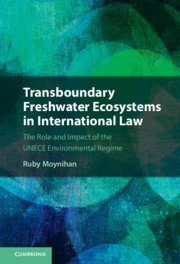 Transboundary Freshwater Ecosystems in International Law
Transboundary Freshwater Ecosystems in International Law Book contents
- Transboundary Freshwater Ecosystems in International Law
- Transboundary Freshwater Ecosystems in International Law
- Copyright page
- Dedication
- Epigraph
- Contents
- Figures
- Preface
- Acknowledgements
- Treaties and Other Instruments
- Table of Cases
- Abbreviations
- 1 The Role of International Law in Addressing the Global Freshwater Ecosystem Crisis
- 2 Conceptualising the UNECE Water and Environmental Regime
- 3 Contemporary Status of International Law on Transboundary Freshwater Ecosystems
- 4 The Common Normative Framework of the UNECE Environmental Regime and Its Contribution to International Water Law
- 5 An Ecosystem Approach in International Law Concerning Transboundary Freshwater Ecosystems
- 6 Public Participation
- 7 River Basin Organisations, Basin Agreements and European Environmental Law in the UNECE Regime
- 8 Transboundary Freshwater Ecosystems in International Law
- Bibliography
- Index
5 - An Ecosystem Approach in International Law Concerning Transboundary Freshwater Ecosystems
Published online by Cambridge University Press: 01 October 2021
- Transboundary Freshwater Ecosystems in International Law
- Transboundary Freshwater Ecosystems in International Law
- Copyright page
- Dedication
- Epigraph
- Contents
- Figures
- Preface
- Acknowledgements
- Treaties and Other Instruments
- Table of Cases
- Abbreviations
- 1 The Role of International Law in Addressing the Global Freshwater Ecosystem Crisis
- 2 Conceptualising the UNECE Water and Environmental Regime
- 3 Contemporary Status of International Law on Transboundary Freshwater Ecosystems
- 4 The Common Normative Framework of the UNECE Environmental Regime and Its Contribution to International Water Law
- 5 An Ecosystem Approach in International Law Concerning Transboundary Freshwater Ecosystems
- 6 Public Participation
- 7 River Basin Organisations, Basin Agreements and European Environmental Law in the UNECE Regime
- 8 Transboundary Freshwater Ecosystems in International Law
- Bibliography
- Index
Summary
In no other ecosystem is biodiversity being irreversibly damaged to the extent that is occurring in inland or freshwater ecosystems. International legal frameworks are failing to reverse the current global freshwater biodiversity crisis. The ecosystem approach has emerged as a promising scientifically and socially progressive approach to managing ecosystems and the vulnerable societies that depend on them. The legal normative content and international legal status of this concept remain unclear. This chapter identifies five international legal elements of an ecosystem approach concerning transboundary freshwater ecosystems, drawing from international biodiversity, wetlands and water law which also includes fair and equitable benefit-sharing. It demonstrates how the UNECE regime provides the strongest clarification of an ecosystem approach, going beyond the UN Watercourses Convention and customary international law but benefits from interpretive clarification under biodiversity and wetlands regimes. The concept of ecosystem services is part of an ecosystem approach and the legal dimensions of this concept are examined. This chapter discusses how the ecosystem approach stimulates cross-sectoral coherence and mutual supportiveness between these different areas of law and contributes to equity in that process. It outlines how international human rights law could be relied upon to promote a stronger equity dimension for ecosystem services.
Keywords
- Type
- Chapter
- Information
- Transboundary Freshwater Ecosystems in International LawThe Role and Impact of the UNECE Environmental Regime, pp. 152 - 201Publisher: Cambridge University PressPrint publication year: 2021
